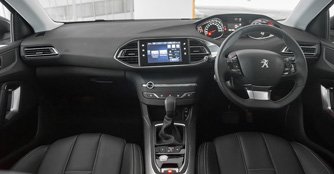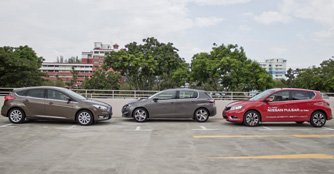Ford Focus Hatchback vs Nissan Pulsar vs Peugeot 308
08 Mar 2017|45,072 views
Ford Focus Hatchback
Sportiest design
Most fun to drive
Good cabin quality but has the smallest boot
Nissan Pulsar
Cabin materials can be improved
Best fuel economy
Most spacious
Peugeot 308
Appealing business-like looks
Modern and expensive-looking cabin
Most powerful of the three
If you're in the market for a comfortable and reasonably spacious hatch, an obvious choice would be the Volkswagen Golf, which is the world's best-seller.
However, should you choose to own something less common, the Ford Focus and the Peugeot 308, as we've found out, make very compelling alternatives to the Golf. But before you decide on any of these European-made hatches, you might want to consider the segment's new kid on the block.

 After spending some time away from Singapore, the Nissan Pulsar is back for a slice of the hatchback pie
After spending some time away from Singapore, the Nissan Pulsar is back for a slice of the hatchback pie
With its re-entry into the local market, the Nissan Pulsar is back to give the aforementioned hatches a serious run for their money. In our test car's Premium trim, the $105,300 Pulsar sits in between the prices of the $99,888 Ford Focus and the $113,888 Peugeot 308, at time of writing.
Style factor
For starters, hatchbacks should be somewhat sporty and youthful in design. In this respect, all three cars do a decent job, with the Focus being the sportiest, thanks to the brand's 'One Ford' global design language and a large trapezoidal grille, which gives the car a more muscular look.
The Pulsar comes in second, with its sporty stance and crisp, sweeping hatchback lines. Its sharp creases have also been shaped for headroom, good all-round visability and aerodynamic efficiency.
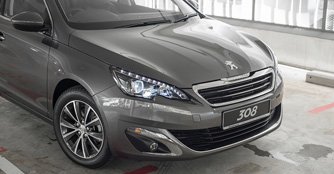
 Peugeots of old often had oddball styling but not this latest 308, which is more premium and executive than ever before
Peugeots of old often had oddball styling but not this latest 308, which is more premium and executive than ever before
While the Focus and Pulsar are more playfully styled, the 308 seems to target buyers an age bracket up. It's easily the most premium-looking in this test and arguably one of the best-looking cars in its class right now.
Competitive cabins
Cabin's shouldn't just look great and be of reasonable quality, but also ergonomical in design.
However, should you choose to own something less common, the Ford Focus and the Peugeot 308, as we've found out, make very compelling alternatives to the Golf. But before you decide on any of these European-made hatches, you might want to consider the segment's new kid on the block.

With its re-entry into the local market, the Nissan Pulsar is back to give the aforementioned hatches a serious run for their money. In our test car's Premium trim, the $105,300 Pulsar sits in between the prices of the $99,888 Ford Focus and the $113,888 Peugeot 308, at time of writing.
Style factor
For starters, hatchbacks should be somewhat sporty and youthful in design. In this respect, all three cars do a decent job, with the Focus being the sportiest, thanks to the brand's 'One Ford' global design language and a large trapezoidal grille, which gives the car a more muscular look.
The Pulsar comes in second, with its sporty stance and crisp, sweeping hatchback lines. Its sharp creases have also been shaped for headroom, good all-round visability and aerodynamic efficiency.

While the Focus and Pulsar are more playfully styled, the 308 seems to target buyers an age bracket up. It's easily the most premium-looking in this test and arguably one of the best-looking cars in its class right now.
Competitive cabins
Cabin's shouldn't just look great and be of reasonable quality, but also ergonomical in design.
Here, the Focus ticks all the right boxes, providing drivers and passengers a utilitarian cabin that's also comfortable and plush. The Focus' dash layout may not be as simple as the Pulsar's or as uptown as the 308's, but it's got a certain feel-good factor when you're in the driver's seat.
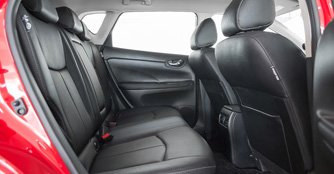
 The Pulsar's cabin provides the most leg and headroom for rear passengers and is the only one with rear air-con
The Pulsar's cabin provides the most leg and headroom for rear passengers and is the only one with rear air-con
The Pulsar's cabin materials aren't as fancy as the Focus' or the 308's. Its numerous hard plastics are a letdown considering it's pricier than the Ford. However, its infotainment system is the most user-friendly and the abundance of space it provides, especially in terms of leg and headroom for rear passengers, is great for families.
Those at the back will appreciate the car's rear air-conditioning, a must-have in Singapore's unforgiving climate, which isn't found in the other two cars. There's also 385 litres of cargo space available, outsizing the Focus' disappointing 316 litres, but losing out to the 308's colossal 470 litres.
But where it loses in rear legroom, the 308 comes back strong with a minimalistic cabin that looks and feels expensive, a panaramic roof and very comfortable seats.

The Pulsar's cabin materials aren't as fancy as the Focus' or the 308's. Its numerous hard plastics are a letdown considering it's pricier than the Ford. However, its infotainment system is the most user-friendly and the abundance of space it provides, especially in terms of leg and headroom for rear passengers, is great for families.
Those at the back will appreciate the car's rear air-conditioning, a must-have in Singapore's unforgiving climate, which isn't found in the other two cars. There's also 385 litres of cargo space available, outsizing the Focus' disappointing 316 litres, but losing out to the 308's colossal 470 litres.
But where it loses in rear legroom, the 308 comes back strong with a minimalistic cabin that looks and feels expensive, a panaramic roof and very comfortable seats.
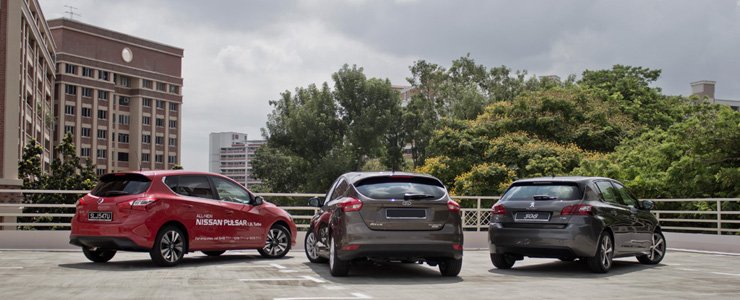 |
The two problems we had with the 308, however, are how controls for air-conditioning are incorporated into its 9.7-inch multifunction touchscreen system, and how abnormally tiny the steering wheel is.
Distinct differences
If you're in the market for a family hatch that also provides a fun-to-drive experience, the Focus is your answer. It's known for its exceptional dynamics and when you drive the three cars back-to-back, the Focus is the obvious corner-carver, thanks to an accurate and well-weighted steering, as well as a balanced chassis and suspension setup.
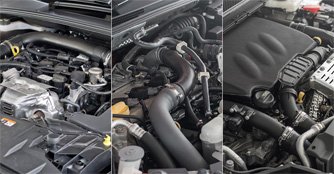
 The Focus (left) is refined, the Pulsar (middle) is more frugal and the 308 (right) has the most power and torque
The Focus (left) is refined, the Pulsar (middle) is more frugal and the 308 (right) has the most power and torque
The Focus doesn't have as much power or torque as the 308, largely because it loses out in engine capacity, but the 123bhp and 170Nm of torque from its 1.0-litre three-cylinder heart is enough for zipping around heartily in Singapore traffic.
Unlike the Focus and 308, which use turbocharged three-cylinders, the Pulsar is the only one that sticks to a conventional four-pot engine. The boosted 1.2-litre unit, paired to a continuously-variable transmission, generates 114bhp and 165Nm of torque.

 We'd replace the Pulsar's uninteresting continuously-variable transmission with a regular autobox if we had a choice
We'd replace the Pulsar's uninteresting continuously-variable transmission with a regular autobox if we had a choice
Because of its power disadvantage and transmission choice, the Pulsar doesn't provide what we'd consider an engaging drive but triumphs in terms of fuel economy. Over our two-day test, the Pulsar returned an averaged 14km/L, proving to be more frugal than the Focus' and 308's 13km/L.
The 308's 129bhp and 230Nm of torque makes it the most powerful car in this comparison.
Distinct differences
If you're in the market for a family hatch that also provides a fun-to-drive experience, the Focus is your answer. It's known for its exceptional dynamics and when you drive the three cars back-to-back, the Focus is the obvious corner-carver, thanks to an accurate and well-weighted steering, as well as a balanced chassis and suspension setup.

The Focus doesn't have as much power or torque as the 308, largely because it loses out in engine capacity, but the 123bhp and 170Nm of torque from its 1.0-litre three-cylinder heart is enough for zipping around heartily in Singapore traffic.
Unlike the Focus and 308, which use turbocharged three-cylinders, the Pulsar is the only one that sticks to a conventional four-pot engine. The boosted 1.2-litre unit, paired to a continuously-variable transmission, generates 114bhp and 165Nm of torque.

Because of its power disadvantage and transmission choice, the Pulsar doesn't provide what we'd consider an engaging drive but triumphs in terms of fuel economy. Over our two-day test, the Pulsar returned an averaged 14km/L, proving to be more frugal than the Focus' and 308's 13km/L.
The 308's 129bhp and 230Nm of torque makes it the most powerful car in this comparison.
It's noticeably faster and punchier than the Focus but isn't as sharp when you throw it around bends. The 308's three-cylinder engine also isn't as refined as the Focus, but this is only evident when you pay close attention.

 Because of its small size, the 308's steering makes turn-ins feel sharper and faster than the Pulsar
Because of its small size, the 308's steering makes turn-ins feel sharper and faster than the Pulsar
Damn, it's a close fight
All three cars have very unique, endearing traits and picking a winner is tough.
Driving the Peugeot 308, you feel like you're behind the wheel of something more expensive. In this segment, the 308's swanky cabin is hard to top. The French manufacturer has indeed created a handsome and capable hatchback. However, at its asking price, you might want to consider a 1.4-litre Volkswagen Golf instead.
As the new kid on the block, the Nissan Pulsar really impresses with its refined powertrain, generous cabin space and driving comfort. Of the three, this would be the car for sensible family men or women, who are also concerned about reliability, long-term running costs and resale value.
But because of how well it drives, looks and makes you feel, the Ford Focus is our favourite this time around. If you don't mind a smaller boot space, the Focus is a good compromise on price, quality, efficiency and dynamics.
After all, a hatchback is a car that's going to be driven quite a fair bit and you'd want one that puts a smile on your face when you do.

Damn, it's a close fight
All three cars have very unique, endearing traits and picking a winner is tough.
Driving the Peugeot 308, you feel like you're behind the wheel of something more expensive. In this segment, the 308's swanky cabin is hard to top. The French manufacturer has indeed created a handsome and capable hatchback. However, at its asking price, you might want to consider a 1.4-litre Volkswagen Golf instead.
As the new kid on the block, the Nissan Pulsar really impresses with its refined powertrain, generous cabin space and driving comfort. Of the three, this would be the car for sensible family men or women, who are also concerned about reliability, long-term running costs and resale value.
But because of how well it drives, looks and makes you feel, the Ford Focus is our favourite this time around. If you don't mind a smaller boot space, the Focus is a good compromise on price, quality, efficiency and dynamics.
After all, a hatchback is a car that's going to be driven quite a fair bit and you'd want one that puts a smile on your face when you do.
Ford Focus Hatchback
Sportiest design
Most fun to drive
Good cabin quality but has the smallest boot
Nissan Pulsar
Cabin materials can be improved
Best fuel economy
Most spacious
Peugeot 308
Appealing business-like looks
Modern and expensive-looking cabin
Most powerful of the three
If you're in the market for a comfortable and reasonably spacious hatch, an obvious choice would be the Volkswagen Golf, which is the world's best-seller.
However, should you choose to own something less common, the Ford Focus and the Peugeot 308, as we've found out, make very compelling alternatives to the Golf. But before you decide on any of these European-made hatches, you might want to consider the segment's new kid on the block.
With its re-entry into the local market, the Nissan Pulsar is back to give the aforementioned hatches a serious run for their money. In our test car's Premium trim, the $105,300 Pulsar sits in between the prices of the $99,888 Ford Focus and the $113,888 Peugeot 308, at time of writing.
Style factor
For starters, hatchbacks should be somewhat sporty and youthful in design. In this respect, all three cars do a decent job, with the Focus being the sportiest, thanks to the brand's 'One Ford' global design language and a large trapezoidal grille, which gives the car a more muscular look.
The Pulsar comes in second, with its sporty stance and crisp, sweeping hatchback lines. Its sharp creases have also been shaped for headroom, good all-round visability and aerodynamic efficiency.
While the Focus and Pulsar are more playfully styled, the 308 seems to target buyers an age bracket up. It's easily the most premium-looking in this test and arguably one of the best-looking cars in its class right now.
Competitive cabins
Cabin's shouldn't just look great and be of reasonable quality, but also ergonomical in design.
However, should you choose to own something less common, the Ford Focus and the Peugeot 308, as we've found out, make very compelling alternatives to the Golf. But before you decide on any of these European-made hatches, you might want to consider the segment's new kid on the block.
With its re-entry into the local market, the Nissan Pulsar is back to give the aforementioned hatches a serious run for their money. In our test car's Premium trim, the $105,300 Pulsar sits in between the prices of the $99,888 Ford Focus and the $113,888 Peugeot 308, at time of writing.
Style factor
For starters, hatchbacks should be somewhat sporty and youthful in design. In this respect, all three cars do a decent job, with the Focus being the sportiest, thanks to the brand's 'One Ford' global design language and a large trapezoidal grille, which gives the car a more muscular look.
The Pulsar comes in second, with its sporty stance and crisp, sweeping hatchback lines. Its sharp creases have also been shaped for headroom, good all-round visability and aerodynamic efficiency.
While the Focus and Pulsar are more playfully styled, the 308 seems to target buyers an age bracket up. It's easily the most premium-looking in this test and arguably one of the best-looking cars in its class right now.
Competitive cabins
Cabin's shouldn't just look great and be of reasonable quality, but also ergonomical in design.
Here, the Focus ticks all the right boxes, providing drivers and passengers a utilitarian cabin that's also comfortable and plush. The Focus' dash layout may not be as simple as the Pulsar's or as uptown as the 308's, but it's got a certain feel-good factor when you're in the driver's seat.
The Pulsar's cabin materials aren't as fancy as the Focus' or the 308's. Its numerous hard plastics are a letdown considering it's pricier than the Ford. However, its infotainment system is the most user-friendly and the abundance of space it provides, especially in terms of leg and headroom for rear passengers, is great for families.
Those at the back will appreciate the car's rear air-conditioning, a must-have in Singapore's unforgiving climate, which isn't found in the other two cars. There's also 385 litres of cargo space available, outsizing the Focus' disappointing 316 litres, but losing out to the 308's colossal 470 litres.
But where it loses in rear legroom, the 308 comes back strong with a minimalistic cabin that looks and feels expensive, a panaramic roof and very comfortable seats.
The Pulsar's cabin materials aren't as fancy as the Focus' or the 308's. Its numerous hard plastics are a letdown considering it's pricier than the Ford. However, its infotainment system is the most user-friendly and the abundance of space it provides, especially in terms of leg and headroom for rear passengers, is great for families.
Those at the back will appreciate the car's rear air-conditioning, a must-have in Singapore's unforgiving climate, which isn't found in the other two cars. There's also 385 litres of cargo space available, outsizing the Focus' disappointing 316 litres, but losing out to the 308's colossal 470 litres.
But where it loses in rear legroom, the 308 comes back strong with a minimalistic cabin that looks and feels expensive, a panaramic roof and very comfortable seats.
The two problems we had with the 308, however, are how controls for air-conditioning are incorporated into its 9.7-inch multifunction touchscreen system, and how abnormally tiny the steering wheel is.
Distinct differences
If you're in the market for a family hatch that also provides a fun-to-drive experience, the Focus is your answer. It's known for its exceptional dynamics and when you drive the three cars back-to-back, the Focus is the obvious corner-carver, thanks to an accurate and well-weighted steering, as well as a balanced chassis and suspension setup.
The Focus doesn't have as much power or torque as the 308, largely because it loses out in engine capacity, but the 123bhp and 170Nm of torque from its 1.0-litre three-cylinder heart is enough for zipping around heartily in Singapore traffic.
Unlike the Focus and 308, which use turbocharged three-cylinders, the Pulsar is the only one that sticks to a conventional four-pot engine. The boosted 1.2-litre unit, paired to a continuously-variable transmission, generates 114bhp and 165Nm of torque.
Because of its power disadvantage and transmission choice, the Pulsar doesn't provide what we'd consider an engaging drive but triumphs in terms of fuel economy. Over our two-day test, the Pulsar returned an averaged 14km/L, proving to be more frugal than the Focus' and 308's 13km/L.
The 308's 129bhp and 230Nm of torque makes it the most powerful car in this comparison.
Distinct differences
If you're in the market for a family hatch that also provides a fun-to-drive experience, the Focus is your answer. It's known for its exceptional dynamics and when you drive the three cars back-to-back, the Focus is the obvious corner-carver, thanks to an accurate and well-weighted steering, as well as a balanced chassis and suspension setup.
The Focus doesn't have as much power or torque as the 308, largely because it loses out in engine capacity, but the 123bhp and 170Nm of torque from its 1.0-litre three-cylinder heart is enough for zipping around heartily in Singapore traffic.
Unlike the Focus and 308, which use turbocharged three-cylinders, the Pulsar is the only one that sticks to a conventional four-pot engine. The boosted 1.2-litre unit, paired to a continuously-variable transmission, generates 114bhp and 165Nm of torque.
Because of its power disadvantage and transmission choice, the Pulsar doesn't provide what we'd consider an engaging drive but triumphs in terms of fuel economy. Over our two-day test, the Pulsar returned an averaged 14km/L, proving to be more frugal than the Focus' and 308's 13km/L.
The 308's 129bhp and 230Nm of torque makes it the most powerful car in this comparison.
It's noticeably faster and punchier than the Focus but isn't as sharp when you throw it around bends. The 308's three-cylinder engine also isn't as refined as the Focus, but this is only evident when you pay close attention.
Damn, it's a close fight
All three cars have very unique, endearing traits and picking a winner is tough.
Driving the Peugeot 308, you feel like you're behind the wheel of something more expensive. In this segment, the 308's swanky cabin is hard to top. The French manufacturer has indeed created a handsome and capable hatchback. However, at its asking price, you might want to consider a 1.4-litre Volkswagen Golf instead.
As the new kid on the block, the Nissan Pulsar really impresses with its refined powertrain, generous cabin space and driving comfort. Of the three, this would be the car for sensible family men or women, who are also concerned about reliability, long-term running costs and resale value.
But because of how well it drives, looks and makes you feel, the Ford Focus is our favourite this time around. If you don't mind a smaller boot space, the Focus is a good compromise on price, quality, efficiency and dynamics.
After all, a hatchback is a car that's going to be driven quite a fair bit and you'd want one that puts a smile on your face when you do.
Damn, it's a close fight
All three cars have very unique, endearing traits and picking a winner is tough.
Driving the Peugeot 308, you feel like you're behind the wheel of something more expensive. In this segment, the 308's swanky cabin is hard to top. The French manufacturer has indeed created a handsome and capable hatchback. However, at its asking price, you might want to consider a 1.4-litre Volkswagen Golf instead.
As the new kid on the block, the Nissan Pulsar really impresses with its refined powertrain, generous cabin space and driving comfort. Of the three, this would be the car for sensible family men or women, who are also concerned about reliability, long-term running costs and resale value.
But because of how well it drives, looks and makes you feel, the Ford Focus is our favourite this time around. If you don't mind a smaller boot space, the Focus is a good compromise on price, quality, efficiency and dynamics.
After all, a hatchback is a car that's going to be driven quite a fair bit and you'd want one that puts a smile on your face when you do.
Car Information
Peugeot 308 1.2 PureTech EAT6 Allure 17" (A)
CAT A|Petrol|19.2km/L
Horsepower
96kW (129 bhp)
Torque
230 Nm
Acceleration
10.7sec (0-100km /hr)
This model is no longer being sold by local distributor
All Used Peugeot 308Ford Focus Hatchback 1.0 Titanium (A)
CAT A|Petrol|18.1km/L
Horsepower
92kW (123 bhp)
Torque
170 Nm
Acceleration
12sec (0-100km /hr)
This model is no longer being sold by local distributor
All Used Ford Focus HatchbackNissan Pulsar 1.2 DIG-T Premium (A)
CAT A|Petrol|19.6km/L
Horsepower
85kW (114 bhp)
Torque
165 Nm
Acceleration
-
This model is no longer being sold by local distributor
All Used Nissan PulsarThank You For Your Subscription.














































